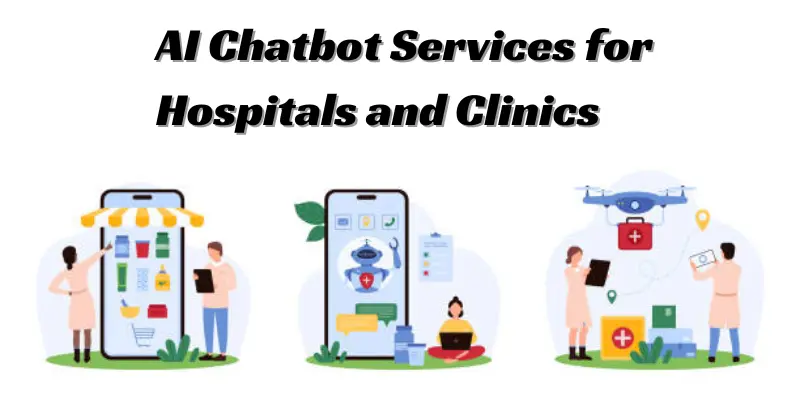Best AI Chatbot Services for Hospitals and Clinics
Published: 29 May 2025
Hospitals and clinics get busy. Patients call, ask questions, book appointments and need updates, all at once. It can get overwhelming for your staff. That’s where AI chatbots step in to help.
Did you know that over 70% of healthcare providers plan to use AI chatbots by 2025? Hospitals and clinics are turning to smart tools to cut wait times, handle patient questions and ease staff pressure. In this guide, we will explore the best AI chatbot services for hospitals and clinics and show how they are making care faster, smoother and more human.
Let’s dive in and see how these tools can make your clinic smarter and more efficient.

Benefits of AI Chatbots in Healthcare
AI chatbots are changing the game for hospitals and clinics. They help staff, support patients and make daily tasks easier. Let’s look at the biggest benefits.
1. Faster Help for Patients
Patients don’t like waiting. With an AI chatbot, they can get answers right away. Whether they want to ask about clinic hours or book a visit, the chatbot is always ready.
Example:
A patient wakes up at 2 a.m. with a question about medicine. The chatbot answers in seconds, no need to call or wait until morning.
2. 24/7 Support
Chatbots never sleep. They work all day, every day. That means your clinic is always open for questions, even after hours or on weekends.
Tip:
Use a chatbot to give after-hours updates, send reminders or share health tips with patients.
3. Less Pressure on Staff
Nurses and front desk teams already have too much to do. Chatbots can handle the small stuff like booking, cancellations and FAQs, so staff can focus on real care.
Example:
Instead of answering 50 calls a day about flu shots, the chatbot shares the schedule and books appointments.
4. Better Patient Engagement
Staying connected with patients is important. Chatbots can send gentle reminders, check in after appointments or even share daily health advice. That keeps your clinic top of mind.
Tip:
Set your chatbot to remind patients about follow ups or send simple wellness tips every week.
5. Organized and Easy Communication
Chatbots don’t forget. They log every message and keep chats clear and easy to track. That helps your team stay on top of things without missing details.
Key Features to Look for in a Healthcare Chatbot
Not all AI chatbots are the same. Some are basic. Others are built just for healthcare. So before you choose one, check if it has the right features. Here’s what to look for.
1. HIPAA Compliance
Your chatbot must protect patient data. In the U.S., that means it needs to follow HIPAA rules.
Simple Explanation:
HIPAA is a law that keeps patient info private. If a chatbot is not HIPAA-compliant, don’t use it in your clinic.
2. Multi-Language Support
Not every patient speaks the same language. A good chatbot should talk to everyone. It must support lots of languages.
Example:
A clinic in a diverse area uses a chatbot that supports English, Spanish and Hindi. Patients feel more welcome and understood.

3. Appointment Booking and Reminders
It is one of the most widely used features. Patients want to book, change or cancel appointments fast.
Why it matters:
It saves your front desk team time and cuts down no-shows by sending reminders.
4. Real-Time Human Escalation
Some patients need more help than a chatbot can give. Make sure your chatbot can connect them to a real person when needed.
Example:
A patient is unsure about symptoms. The chatbot offers to connect them with a nurse for live chat or a call.
5. Integration with EHR Systems
Your chatbot should “talk” to your existing tools. That means it should connect with your existing EHR (Electronic Health Records) system. It helps in keeping patient data in one place and avoids double work.
Tip:
Look for chatbots that work with popular systems like Epic, Cerner or Athenahealth.
6. Easy to Use Interface
Both staff and patients should find it simple to use. Buttons, clear choices and friendly text make a big difference.
Example:
A senior patient can tap one button to confirm an appointment, no typing needed.
Quick Checklist:
✅ HIPAA compliance
✅ Multi-language support
✅ Appointment booking
✅ Human hand-off
✅ EHR integration
✅ Simple interface
Top 5 AI Chatbot Services for Hospitals and Clinics
Choosing the right chatbot can feel confusing. So we have broken down the top 5 AI chatbot services that work well for clinics, hospitals and private practices. Each one has unique strengths. Let’s explore them.
1. Ada Health
Ada is like a smart health assistant. It asks patients simple questions about their symptoms and then gives clear advice. It does not diagnose but guides users to the right care.
Best For:
Clinics that want to help patients figure out if they should come in or stay home.
Top Features:
- Symptom checker with medical knowledge
- Easy to use on mobile or desktop
- Available in multiple languages
- Trusted by health systems around the world
Real Example:
A patient feels lightheaded and tired. Ada asks questions like “Do you feel dizzy when you stand up?” Based on the answers, it suggests seeing a doctor soon.
What Makes It Great:
It saves time for nurses and doctors by helping patients decide what to do, before they call or visit.
2. HealthTap AI
HealthTap combines a smart chatbot with live doctor access. The chatbot helps patients with questions and symptoms. If needed, it connects them to a real doctor for video visits.
Best For:
Clinics that want to offer 24/7 support, even without full time staff.
Top Features:
- AI-powered triage chatbot
- Live video doctor consultations
- Health records and visit history saved
- Works well on phones and tablets
Real Example:
A patient wakes up with a sore throat. The chatbot checks symptoms and then offers a video call with a doctor in minutes.
What Makes It Great:
It blends AI and real care. Your clinic can offer round-the-clock support without hiring more staff.
3. GYANT
GYANT is a powerful chatbot that works well with hospital systems. It does more than chat. It helps with symptom checking, patient intake and follow-ups. Plus, it connects with EHRs like Epic.
Best For:
Hospitals and large clinics that use electronic records and need full integration.
Top Features:
- Fully customizable conversations
- Smart intake forms before visits
- Chatbot guided follow-up after care
- Strong EHR integration (Epic, Cerner)
Real Example:
A patient books an appointment online. GYANT collects symptoms, shares them with the doctor and follows up after the visit to check on recovery.
What Makes It Great:
It cuts admin work, improves patient flow and keeps records in one place.
4. Sensely
Sensely stands out with its friendly “digital nurse” avatar. This visual chatbot talks to patients using both voice and text. It’s helpful for managing chronic conditions like asthma or diabetes.
Best For:
Clinics focused on long-term care or working with patients who speak different languages.
Top Features:
- Virtual nurse avatar that speaks and chats
- Great for chronic disease check-ins
- Supports many languages
- Connects with clinical systems
Real Example:
A diabetic patient uses Sensely weekly. The chatbot asks, “How are your blood sugar levels today?” and shares simple care advice.
What Makes It Great:
It feels more personal and engaging, perfect for patients who need regular support.
5. Babylon Health
Babylon offers more than just a chatbot. It’s a full digital health platform with chat, health tracking and video visits. It’s used worldwide in public and private healthcare.
Best For:
Clinics and health systems that want a complete digital health solution.
Top Features:
- AI chatbot for symptom triage
- Video appointments with doctors
- Health tracking tools for patients
- Integrates with EHR and mobile devices
Real Example:
A patient chats with Babylon about chest tightness. The bot triages the concern and quickly schedules a virtual visit with a doctor.
What Makes It Great:
It gives clinics a complete digital system, from first chat to full care.
Quick Comparison Table (Updated)
| Chatbot Tool | Best For | Top Features | EHR Integration | Multi-Language |
| Ada Health | Symptom checking | Smart triage, multi-language | ❌ | ✅ |
| HealthTap | Live doctor chat | AI chatbot + real doctor video visits | ❌ | ✅ |
| GYANT | Hospital integration | Intake, follow-up, full EHR connection | ✅ | ✅ |
| Sensely | Chronic care + engagement | Digital nurse avatar, voice chat, multilingual | ✅ | ✅ |
| Babylon | All-in-one digital health tool | Chatbot, doctor visits, patient health tracking | ✅ | ✅ |
How to Choose the Right Chatbot for Your Clinic
Picking the right AI chatbot can be simple if you follow these easy steps. Think about what your clinic needs and who your patients are.
Step 1: Decide What You Need
It’s also called the audit. First check your hospital or clinic for limitations. After checking, Ask yourself:
- Do you want to answer patient questions faster?
- Do you need help collecting patient info before visits?
- Do you want to support patients with long term illnesses?
Example:
If your clinic gets many calls about symptoms, a chatbot like Ada can handle those questions and save your staff time.
Step 2: Think About Your Patients
Take a closer look at the health records for having an idea about the patients. You can also use AI to configure the data. Consider:
- Are your patients mostly young or old?
- Do many speak different languages?
- Do they have ongoing health issues?
Tip:
If many patients have long-term care needs, a chatbot like Sensely is great. It checks in regularly and reminds patients about their care.
Step 3: Check Your Current Systems
Look at the tools you already use and choose the system which quickly integrate with your existing system:
- Do you have an electronic health record (EHR) system?
- Do you offer online appointments?
- Do you have video visits?
Example:
If your clinic uses an EHR like Epic, pick a chatbot like GYANT that connects with it easily. This helps keep all patient info in one place.

Step 4: Think About Cost
Chatbots cost different amounts:
- Some have free or cheap plans with basic features.
- Others charge more for advanced tools.
Tip:
Try a simple chatbot first like HealthTap or Ada. Then upgrade when you’re ready.
Step 5: Test the Chatbot
After finalizing the chatbot, try it out:
- Let your staff use it.
- Have a few patients test it too.
- Ask for feedback on how easy it is.
Tip:
Pick a chatbot that’s simple and friendly. It should be easy for patients and staff to use.
Step 6: Check Support and Security
Make sure the chatbot:
- Has good customer support.
- Updates often to fix bugs and improve.
- Keeps patient data safe and private.
Example:
Big services like Babylon and GYANT offer strong support and protect patient information well.
Case Study: Intermountain Healthcare Reduces Call Center Volume by 30% with AI Chatbot
Background:
Intermountain Healthcare, a prominent health system in the United States, faced challenges during the COVID-19 pandemic. Their call centers were overwhelmed with inquiries about symptoms, testing locations and general health advice.
Solution:
To alleviate this burden, Intermountain implemented Fabric’s conversational AI platform, integrated into their My Health+ app. This AI-powered assistant provided patients with 24/7 access to COVID-19 screenings and care navigation, guiding them through their healthcare journey.
Results:
- 30% Decrease in Call Center Volume: The AI assistant handled a significant portion of routine inquiries, allowing call center staff to focus on more complex cases.
- 157,000 Users Assisted: Over the initial weeks, the platform engaged with approximately 7,500 users daily, providing timely information and reducing wait times.
- Improved Resource Allocation: With a clearer scope of inquiries, the call center could prioritize urgent cases, enhancing overall efficiency.
Impact:
By leveraging AI, Intermountain Healthcare not only reduced operational strain but also improved patient satisfaction by providing quick and accurate information during a critical time.
Takeaway:
This real life case study demonstrates how AI chatbots can effectively manage high volumes of patient inquiries, leading to reduced call center traffic, better resource allocation and enhanced patient experience.
Conclusion
AI chatbot services are changing how hospitals and clinics care for patients. They save time, reduce staff workload and make it easier for patients to get help anytime. From answering simple questions to booking appointments, these tools improve the whole healthcare experience.
Choosing the right chatbot takes some thought but it’s worth it. Start small, test your options and find the one that fits your clinic’s needs.
Remember, technology like AI chatbots is here to help your clinic grow and serve patients better. Don’t wait, explore AI chatbot services for hospitals and clinics today and see the difference it can make for your healthcare team and patients!
Related Queries
Here are frequently asked questions about Healthcare AI chatbots in Hospitals and Clinics:
Most healthcare AI chatbots offer tiered pricing based on features and usage volume. Basic plans can start around $50-200 per month for small clinics while enterprise solutions for hospitals may cost $1,000-5,000+ monthly. Many providers offer free trials or demos, so you can test the system before committing to a paid plan.
Healthcare chatbots are designed to provide general information and guidance, not diagnose or replace doctors. They typically include disclaimers and are programmed to escalate complex cases to human staff. Most reputable chatbot providers carry professional liability insurance and work with healthcare organizations to establish clear protocols for handling medical inquiries.
Basic chatbot setup can take 1-4 weeks depending on customization needs and system integrations. Training the bot with your clinic’s specific information (hours, services, common questions) usually takes a few days to a week. Most providers offer implementation support and training for your staff during the setup process.
Yes, most modern healthcare chatbots are mobile friendly and work through web browsers, mobile apps or messaging platforms like SMS. Patients can typically access the chatbot from any device with internet connection. Some chatbots also offer dedicated mobile apps for a more streamlined experience.
You can still use AI chatbots even without an EHR system though you will miss some integration benefits. Basic chatbots can handle appointment booking, FAQs and patient communication independently. When you are ready to implement an EHR, many chatbot providers can help migrate data and establish integrations.
Good chatbots always include an option to connect with human staff when needed. You can set up the bot to offer human handoff for complex questions or upon patient request. Many clinics use a hybrid approach where the chatbot handles routine tasks but seamlessly transfers patients to staff for personalized care.
As long as you choose HIPAA compliant chatbots and follow proper protocols, legal risks are minimal. The main considerations are data privacy, clear disclaimers about the bot’s limitations and proper escalation procedures. It’s wise to review your malpractice insurance and consult with a healthcare attorney when implementing new technology.
Most chatbots can help patients request prescription refills by collecting basic information and forwarding it to appropriate staff. However, they typically cannot provide lab results or make prescription decisions directly. These sensitive tasks usually require human verification and are handled through secure patient portals or direct communication with healthcare providers.
Chatbots require internet connection to function since they operate on cloud based systems. If your clinic’s internet goes down, the chatbot won’t be available but patients can still call your regular phone line. Most chatbot services have high uptime rates approx 99%+ and operate on reliable cloud infrastructure to minimize outages.
Most chatbot platforms provide analytics dashboards showing metrics like number of conversations, common questions, resolution rates and time saved. Key indicators include reduced phone call volume, faster response times, improved patient satisfaction scores and staff time freed up for other tasks. Many providers offer monthly reports to help you track ROI and optimize performance.





